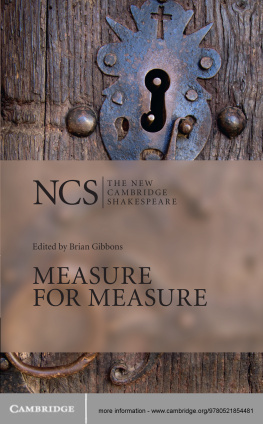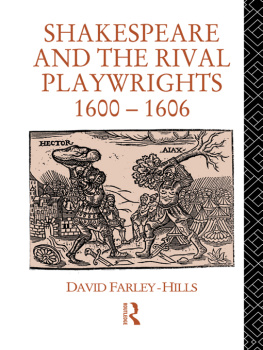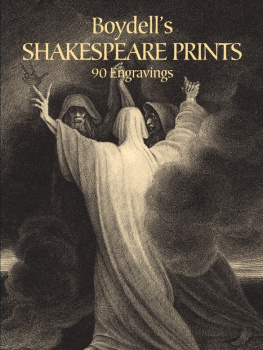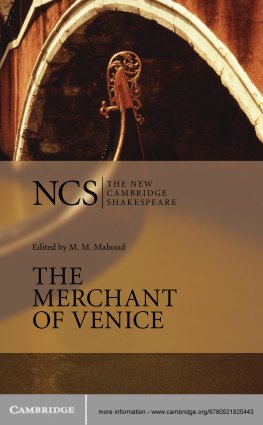William Shakespeare edited by Brian Gibbons - Measure for Measure
Here you can read online William Shakespeare edited by Brian Gibbons - Measure for Measure full text of the book (entire story) in english for free. Download pdf and epub, get meaning, cover and reviews about this ebook. publisher: Cambridge University Press, genre: Detective and thriller. Description of the work, (preface) as well as reviews are available. Best literature library LitArk.com created for fans of good reading and offers a wide selection of genres:
Romance novel
Science fiction
Adventure
Detective
Science
History
Home and family
Prose
Art
Politics
Computer
Non-fiction
Religion
Business
Children
Humor
Choose a favorite category and find really read worthwhile books. Enjoy immersion in the world of imagination, feel the emotions of the characters or learn something new for yourself, make an fascinating discovery.
- Book:Measure for Measure
- Author:
- Publisher:Cambridge University Press
- Genre:
- Rating:4 / 5
- Favourites:Add to favourites
- Your mark:
- 80
- 1
- 2
- 3
- 4
- 5
Measure for Measure: summary, description and annotation
We offer to read an annotation, description, summary or preface (depends on what the author of the book "Measure for Measure" wrote himself). If you haven't found the necessary information about the book — write in the comments, we will try to find it.
Measure for Measure — read online for free the complete book (whole text) full work
Below is the text of the book, divided by pages. System saving the place of the last page read, allows you to conveniently read the book "Measure for Measure" online for free, without having to search again every time where you left off. Put a bookmark, and you can go to the page where you finished reading at any time.
Font size:
Interval:
Bookmark:
THE NEW CAMBRIDGE SHAKESPEARE
GENERAL EDITOR
Brian Gibbons
ASSOCIATE GENERAL EDITOR
A. R. Braunmuller, University of California, Los Angeles
From the publication of the first volumes in 1984 the General Editor of the New Cambridge Shakespeare was Philip Brockbank and the Associate General Editors were Brian Gibbons and Robin Hood. From 1990 to 1994 the General Editor was Brian Gibbons and the Associate General Editors were A. R. Braunmuller and Robin Hood.
MEASURE FOR MEASURE
Since the rediscovery of Elizabethan stage conditions early in the twentieth century, admiration for Measure for Measure has steadily risen. It is now a favourite with the critics and has attracted widely different styles of performance. At one extreme, the play is seen as a religious allegory; at the other, it has been interpreted as a comedy protesting against power and privilege.
Brian Gibbons focuses on the unique tragi-comic experience of watching the play, the intensity and excitement offered by its dramatic rhythm, the reversals and surprises which shock the audience even to the end. His introduction considers how the plays critical reception and stage history have varied according to prevailing social, moral and religious issues, which were highly sensitive when Measure for Measure was written, and have remained so to the present day. This updated edition contains a new introductory section by Angela Stock, which describes recent stage, film and critical interpretations, and an updated reading list.
THE NEW CAMBRIDGE SHAKESPEARE
Alls Well That Ends Well, edited by Russell Fraser
Antony and Cleopatra, edited by David Bevington
As You Like It, edited by Michael Hattaway
The Comedy of Errors, edited by T. S. Dorsch
Coriolanus, edited by Lee Bliss
Cymbeline, edited by Martin Butler
Hamlet, edited by Philip Edwards
Julius Caesar, edited by Marvin Spevack
King Edward III, edited by Giorgio Melchiori
The First Part of King Henry IV, edited by Herbert Weil and Judith Weil
The Second Part of King Henry IV, edited by Giorgio Melchiori
King Henry V, edited by Andrew Gurr
The First Part of King Henry VI, edited by Michael Hattaway
The Second Part of King Henry VI, edited by Michael Hattaway
The Third Part of King Henry VI, edited by Michael Hattaway
King Henry VIII, edited by John Margeson
King John, edited by L. A. Beaurline
The Tragedy of King Lear, edited by Jay L. Halio
King Richard II, edited by Andrew Gurr
King Richard III, edited by Janis Lull
Loves Labours Lost, edited by William C. Carroll
Macbeth, edited by A. R. Braunmuller
Measure for Measure, edited by Brian Gibbons
The Merchant of Venice, edited by M. M. Mahood
The Merry Wives of Windsor, edited by David Crane
A Midsummer Nights Dream, edited by R. A. Foakes
Much Ado About Nothing, edited by F. H. Mares
Othello, edited by Norman Sanders
Pericles, edited by Doreen DelVecchio and Antony Hammond
The Poems, edited by John Roe
Romeo and Juliet, edited by G. Blakemore Evans
The Sonnets, edited by G. Blakemore Evans
The Taming of the Shrew, edited by Ann Thompson
The Tempest, edited by David Lindley
Timon of Athens, edited by Karl Klein
Titus Andronicus, edited by Alan Hughes
Troilus and Cressida, edited by Anthony B. Dawson
Twelfth Night, edited by Elizabeth Story Donno
The Two Gentlemen of Verona, edited by Kurt Schlueter
The Two Noble Kinsmen, edited by Robert Kean Turner and Patricia Tatspaugh
The Winters Tale, edited by Susan Snyder and Deborah T. Curren-Aquino
THE EARLY QUARTOS
The First Quarto of Hamlet, edited by Kathleen O. Irace
The First Quarto of King Henry V, edited by Andrew Gurr
The First Quarto of King Lear, edited by Jay L. Halio
The First Quarto of King Richard III, edited by Peter Davison
The First Quarto of Othello, edited by Scott McMillin
The First Quarto of Romeo and Juliet, edited by Lukas Erne
The Taming of a Shrew: The 1594 Quarto, edited by Stephen Roy Miller
MEASURE FOR MEASURE
Updated edition
Edited by
BRIAN GIBBONS

CAMBRIDGE UNIVERSITY PRESS
Cambridge, New York, Melbourne, Madrid, Cape Town,
Singapore, So Paulo, Delhi, Mexico City
Cambridge University Press
The Edinburgh Building, Cambridge CB2 8RU, UK
Published in the United States of America by Cambridge University Press, New York
www.cambridge.org
Information on this title: www.cambridge.org/9780521854481
Cambridge University Press, 1991, 2006
This publication is in copyright. Subject to statutory exception and to the provisions of relevant collective licensing agreements, no reproduction of any part may take place without the written permission of Cambridge University Press.
First published 1991
Reprinted 1995, 1997, 1999, 2003 (twice), 2004 (twice)
Updated edition 2006
7th printing 2012
Printed and bound by CPI Group (UK) Ltd, Croydon CRO 4YY
A catalogue record for this publication is available from the British Library
ISBN 978-0-521-85448-1 Hardback
ISBN 978-0-521-67078-4 Paperback

Cambridge University Press has no responsibility for the persistence or accuracy of URLs for external or third-party internet websites referred to in this publication, and does not guarantee that any content on such websites is, or will remain, accurate or appropriate.

ILLUSTRATIONS
Illustration by permission of Sophie Baker.
PREFACE
Between the closing of the theatres by the Puritans at the time of the English Civil War in 1642 and the rediscovery of Elizabethan stage conditions in the period near the beginning of the First World War in 1914, Measure for Measure was not one of Shakespeares more popular plays, either with readers or on the stage. Its out-spokenness on sex, crime and social divisions, topics which increasingly polite society preferred not to mention, would perhaps have been enough to secure unpopularity, but in addition the plays exploitation of the mixed dramatic mode of tragi-comedy was not understood, especially by readers familiar only with neoclassical dramatic rules for comedy and tragedy. Certainly the play deals with painful experience, and to read it or see it performed may be a troubling as well as a humorous and moving experience, although in recent times admiration for it has steadily risen and since the end of the Second World War the play has been more and more frequently performed in the theatre.
In this play the mixed genre of tragi-comedy involved the bringing together of seemingly incompatible narrative materials and deliberately contrasting dramatic styles, which the dramatist would strive to combine in a design offering a spectacularly surprising conclusion, just when this seemed least possible. Perhaps it is more true of this play than of other Shakespeare plays that each fresh production presents it in a different shape by making its own choice of tone, rhythm and emphasis among a number of different yet most important issues. Yet where a selective emphasis may be the key to theatrical interpretation (as the stage history on pp. 5168 shows) it is one of the duties of an editor to try to give recognition to the sheer variety of elements heterogeneous and volatile though they may be which Shakespeare includes in
Next pageFont size:
Interval:
Bookmark:
Similar books «Measure for Measure»
Look at similar books to Measure for Measure. We have selected literature similar in name and meaning in the hope of providing readers with more options to find new, interesting, not yet read works.
Discussion, reviews of the book Measure for Measure and just readers' own opinions. Leave your comments, write what you think about the work, its meaning or the main characters. Specify what exactly you liked and what you didn't like, and why you think so.










